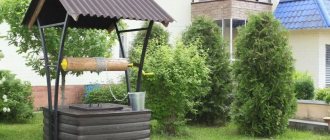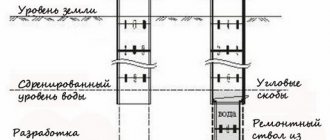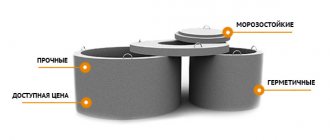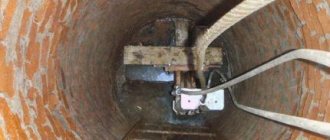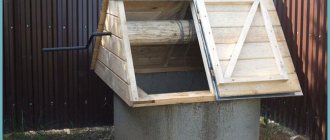Purpose of the stairs
The main function is the need to periodically perform maintenance or repairs on the structure. It happens that if the head of the well is not sealed with anything (a lid or other decorative structure), then foreign objects may fall into the shaft from time to time. To keep the water clean, they need to be pulled out. To solve the problem, again, a ladder is used.
During operation, a circuit break may occur. To restore the structure, we will have to somehow organize a descent down. These are the main points when it is necessary to use ladders for wells. Considering that all the described cases do not require daily human intervention, the most convenient is a removable option with compact dimensions and light weight, which is exactly what the rope version is characterized by.
Well cleaning and repairs are carried out using a ladder
Existing types of stairs for wells
Depending on the user's requirements for the release device, you can choose one of the following options:
- metal brackets that are mounted into the wall of the shaft;
- an extension ladder made of wood or metal;
- rope construction.
It is advisable to consider staples in cases where other solutions are not suitable for various reasons. There are several significant disadvantages to metal steps built into the wall of a well. First of all, there is a risk of rust formation.
Tip: To extend the service life of this design, it is highly recommended to coat the brackets with anti-corrosion paint.
In addition, damage to the surface of the brackets over time can lead to leaks in the shaft. For this reason, this option cannot be used in drinking wells. And as a ladder for sewer wells - it is permissible.
Well ladder made of metal brackets
An attached structure made of wood is much better than the solution just discussed. It is stable and easy to climb down thanks to its inclination. However, there are also some disadvantages: the attached version is not used in deep water wells, since in this case the ladder for cleaning the wells must be quite long, and this not only complicates the transportation and operation of the product, but also complicates its storage.
A similar metal version of the attached structure is little better than a wooden one, since it is even heavier, and it is very difficult to transport such a metal ladder for a well on its own, much less install it in a shaft. The main advantage of this solution is the presence of hooks in the upper part, which allows you to hook the structure to the head of the well.
Metal ladder in a well
Rope versions are in many ways more convenient to use, store and transport. This is due to the compactness of the design itself (a small width of the steps for descent is sufficient), and relatively low weight due to the type of materials used. In addition, you can make it yourself in a short time.
The rope ladder is lightweight and takes up minimal space
Descent options
Tap
A VL-2 drainage stepladder was specified for the water well.
Made of metal or stainless steel, with mandatory fastening to the collector neck and its walls. Parameters specified in SNiP: length 182 cm, width 48 cm, weight 20 kg. There are special hooks on top to cling to the edge of the well. Along the entire length, additional means of attaching the stepladder to the walls of the collector are installed.
Sewer
The environment inside the sewer is always aggressive.
Evaporation from sewage passing through the pipe remains in the shaft and accumulates there. In addition, constant humidity has a detrimental effect on metal products. Therefore, they install a structure of a special shape and special treatment of the steps. It is slightly wider than usual and has a rounded shape. In addition, the steps are spaced out across two compartments.
Review of the advantages of rope structures
Comparing with analogues, we can highlight a number of significant advantages, thanks to which the task of maintaining a well is simplified:
- Mobility, due to the low weight of the materials used in manufacturing. This allows you to transport the ladder to any distance without the need to involve assistants.
- Compact dimensions, which opens up wide possibilities for storing the product.
- The ladder can be easily adjusted in length, so it can be used to service wells of any depth.
- The affordable cost of materials allows you to avoid large expenses.
- Easy to install, since a DIY rope ladder does not require special knowledge to implement such a solution.
- Possibility of use for absolutely any task of organizing descent.
Such a design can be used even in situations where it would seem problematic to descend to a certain depth.
Safety requirements for operation
Despite a fairly large number of advantages, such structures can be dangerous if they are made without relying on the basic safety requirements:
- In order to avoid restrictions on the use of the ladder in the future, it is necessary that the maximum supported weight of the product reaches 360 kg. This will ensure that the structure can be used by adults of a large weight category.
- If the task is to make a mobile ladder for descending into a well, then its total weight should not exceed 20 kg, which will be determined by the dimensions (width and length) of the product, as well as the materials used.
- To avoid direct contact of the steps with the shaft wall, the structure is equipped with special stops, the length of which can vary between 11-22 cm.
- The steps can have a round or rectangular cross-section. In the first case, the minimum acceptable value of the parameter corresponds to 2.6 cm.
- The steps should be located at a distance sufficient for a step (no more than 35 cm).
- The rope ladder for servicing the well should not be narrower than 25 cm. The recommended length for trouble-free operation is 15 m.
- The steps should have smooth corners, as sharp edges can injure a person.
As you can see, it is quite possible to create a simple and lightweight design that will not take up much space during storage and will be operated without unnecessary difficulties.
Sewer ladders and their components
Installing a well ladder is a responsible issue. If we are talking about a sewer or drainage modification that is attached to the walls of the well, then you will have to take care of a reliable and durable fastening.
The ZhBI-4 plant produces brackets for wells
, facilitating not only the installation of stairs, but also the operation of the entire well.
- Thrust brackets of SK-1 and SK-1 modifications with fastening.
- Suspension brackets of modifications SK-2, SK-3, SK-4, SK-5, SK-6.
- Fastening brackets for modifications GS-1, GS-2, GS-3, GS-4.
All brackets for wells are made of steel reinforcement with a diameter of 22 and 25 mm. At the customer's request, brackets for wells can be made according to an individual sketch.
Specialists from the ZhBI-4 plant will help you choose a ladder or brackets of the required modification; we are always ready to answer customer questions by phone or via the Internet. Such prompt communication allows us to place orders in a timely manner and complete the necessary items of our assortment in the required quantities.
What materials are acceptable to use?
To ensure the ability to support a fairly large weight (for example, one or even several adults), it is recommended to choose a material from several recommended options.
To create the basis of the structure, the following are used:
- polyester;
- cotton fiber;
- rope made of flax or hemp;
- nylon materials.
Each of the options is characterized by a high degree of strength, ease of use (fold the rope structure and unfold it), not to mention ease of transportation.
When considering natural and synthetic fibers, the choice is often made in favor of the latter material due to the fact that it is characterized by greater moisture resistance, a long service life, as well as increased resistance to aggressive substances, in particular solvents.
When making a ladder into a well with your own hands, it is also necessary to select the materials from which the steps will be made.
The following are considered suitable options:
- metal (usually light alloys, so as not to weigh down the structure);
- wood is the most common solution;
- plastic;
- the same rope from which the base of the structure was made.
Metal steps are the strongest, however, if the edges are poorly processed, the rope will fray, since the fastening points are in very close contact with the steps. Wood and other materials are lighter, but, accordingly, less reliable, with the exception of rope, but this is not an ideal solution, since in this case it is not very convenient to use the ladder due to the lack of structural rigidity.
Nuances of securing and installing the structure
Before you start manufacturing, you need to weigh the pros and cons. The following are recommendations from experts that may be useful:
- You should not make a device out of metal if you will not use the item often.
- The type of design determines the possibility of using the ladder in other areas of the economy.
- To go down into well pits, it is best to use a portable stepladder if the size of the complaint does not allow organizing a stationary option.
- If the well chamber is made of brick or concrete and a decision is made to build an internal structure, it is necessary to use anchor bolts to secure the steps.
- Metal fastenings for steel ladders are of great importance. It is better to purchase a ready-made version in construction stores.
Ladder for a well in work
Note! Removable structures do not need to be secured.
The best option for those who need such a device, but will not use it often, is a rope device. To do it, it does not require serious expenses and a lot of time. The ladder will turn out to be very light and compact, but also not particularly durable, like a wooden product. Stainless steel or metal is an expensive material and heavy, but it is resistant to aggressive environments and ensures structural reliability.
Manufacturing instructions
Method 1
When the question is how to make a rope ladder with your own hands, you need to prepare a reliable option for attaching the steps. This is the “Constrictor” knot.
Constrictor knot
The length of the rope is selected based on the depth to which the ladder will have to be lowered. Rope diameter: 8-12 mm. To work you will need wooden cuttings. Based on the length of the rope used as the basis of the structure (for example, 20 m on each side), the number of pre-polished cuttings from which the crossbars will be cut is determined. The diameter of each element is 3 cm, length 30-40 cm.
Guided by the total length of the rope and the recommended step distance (the value of this parameter is specified by safety requirements), the number of steps is determined. In this case, you need to use 25 pcs. crossbars
Knitting with a “Constrictor” knot does not involve drilling holes, but for the strength of the structure you need to make grooves, stepping back 1 cm from the edge of the handle on each side. Recommended slot dimensions: depth 0.3 cm, width 1.5 cm.
Tip: To simplify the task, you should mark the location of the grooves, make cuts, and only then use a sharply sharpened knife to make grooves of sufficient size.
After completing this work, the surface of the step is treated with sandpaper until the chips and roughness are completely smoothed out.
Having prepared the tree, it is necessary to process the ends of the rope. This can be done by singeing the material along the edge, or during cutting, use a very hot knife, which performs two functions at once: cutting the rope and processing the edges. Next, observing the step, loops are made on each of the ropes with a diameter slightly larger than the steps, and the cuttings are fixed with them. This is done based on the fact that the distance between the steps will be 35 cm.
The cuttings, acting as steps of the staircase, are tied with a knot
The loops at both ends of the ropes remain empty, thereby ensuring the fixation of the structure. Their diameter should be about 6 cm.
If you want to make a well cover with your own hands, step-by-step instructions are available on our website. Several manufacturing methods are considered.
What do you need to know to repair the Baby pump yourself? The answer is in our material.
There is information about well pumps and their choice on this page.
Method 2
You can choose another option that requires drilling holes. Sufficient dimensions of the bars: 4x4 cm, their length should be within 30-40 cm. Drilling is performed at a distance of 3-4 cm from the edge on both sides of the crossbar. The diameter of the hole corresponds to the size of the rope (+/-1 mm). The first step is to tie a figure eight knot, then thread the end of the rope through the hole, after which a loop is made to tie around the crossbar. The distance between the steps and the width of the stairs are repeated as in the previous case. To maintain the distance between steps during the manufacturing process, you can use an improvised device.
Making a rope ladder with drilled rungs
The process described above is clearly shown in the video.
Thus, simple calculations in practice confirm the possibility of manufacturing a rope structure. This will not cost much, given the cost of the basic materials, and the work is carried out quite quickly, since the main difficulty lies in preparing the crossbars (marking holes at a certain distance). In terms of efficiency in use, this option is the most preferable among others. And although the price for ready-made stairs for wells is not so high, it can be much nicer and more interesting to do such a thing yourself.
